In Search Of The Other Spain In Asturias
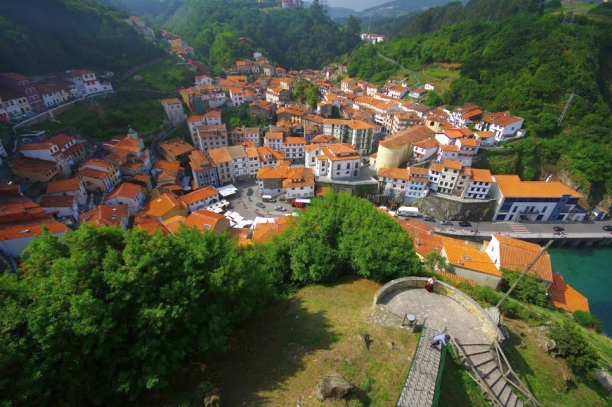
Spain is a well-oiled tourism machine. In addition to the coastal resorts that established themselves in the ‘60s and ‘70s and any number of tomato-pelting, bull-running festivals made famous by Hemingway and the like, Spanish tourism nowadays seeks to cater to the visitor on the lookout for culture, for history, for sport, for spiritual retreats and food odysseys, riding, hiking climbing and skiing, painting and writing, winetasting and walking.
It has got it all, in other words. Not surprisingly, perhaps, for a country mired in its own economic woes, modern Spain seeks to be everything to everyone. Can it have its Tarta de Santiago and eat it though? Can the country that attracts more visitors than just about anywhere else in the world accommodate that trickiest of customers: the visitor who doesn’t like other visitors? This August, at the height of both domestic and international tourist season all over Spain, I got into a car at my home in the country’s southern tip with a notepad and camera in hand along wtih my fiancée, K, and we headed north to find out.
We had set ourselves a serious challenge: to find some quiet and solitude in a country that voluntarily fills itself to the rim with visitors every summer in an annual attempt to gorge itself on the tourist dollar by any and all means necessary. You name it: beaches, discos, golf resorts, castles, casinos, water parks, museums, markets, bodegas, brothels and bars. They pull out all the stops here, and we fully expected to have to work to find our peace and quiet.
It took about 20 minutes.
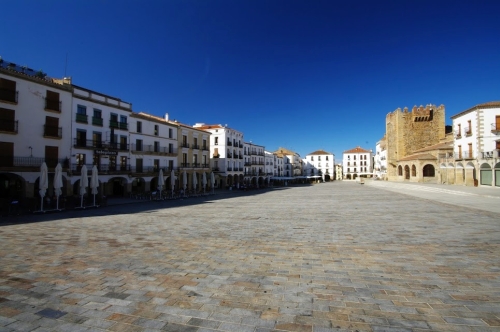
Very few things I’ve ever come across are as long, straight or empty as a Spanish road. This is a big country; the motorways that connect the southern coast with Seville and places like Mérida and Cáceres, an ancient town roughly 185 miles north of the bay of Cádiz, cut across open terrain, parched by the summer to a yellow dust and strewn with boulders and rickety olive groves. Huge skies towered overhead, and for long stretches, ours was the only car.
We stopped in Cáceres for a night to take a look at its famous old town, built largely on the wealth of those returning from a bit of plunder in the New World, but with roots going back to the Romans and beyond. It was hot and it was busy, but an early morning walk, even in August, furnished a quiet and undisturbed experience. As the sun rose over the towers and turrets, we unexpectedly had the place to ourselves.
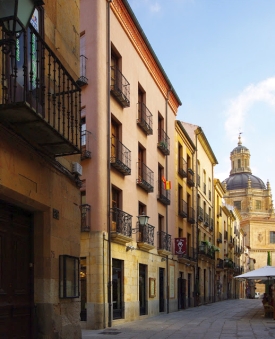
We spent the following few days on city breaks in Salamanca and León, enjoying architecture and bar life. It was the middle of August, and despite the fact that both were normally two bustling university towns, we were able to stroll unhurriedly through sparsely populated streets. We had the tower of Salamanca’s cathedral to ourselves and the whole of León’s wonderfully Gothic House of Light was ours as we sat in an empty square at night and enjoyed an illuminated and uninterrupted view.
That was it for cities. Continuing north, we headed for Asturias — beloved of the Spanish and largely unknown to the foreigner, and also the main focus of our trip. Asturias is a mountainous region that hugs the country’s north coast and defies just about any preconceived notion of Spain you might think of. There is no flamenco here. Cider is preferred to wine. The hillsides are a deep green and the cheese is blue.
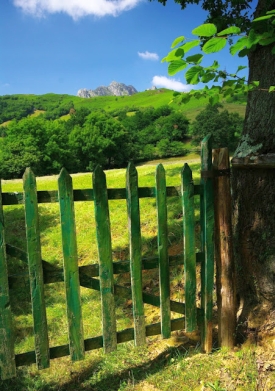
Ironically, the only region of old Spain never conquered and influenced by Arab invaders has become possibly the least recognizable as Spanish, at least in the stereotypical sense. We would end up on the coast — an important moment for us, having driven from its counterpart in the south with its views of Africa, to this fresher, cooler shore that faces in Ireland’s direction. We would feel some irritation in Cudillero, a lovely fishing village swamped with tourists on an August weekend, reduced to the status of parking lot and fridge-magnet emporium. We would swear never to travel in the summer vacation season again, if we could help it.
First, though, we would spend a few days in the region’s highlands. In the average Spanish mind, these mountains stand for many things. Milk and butter from the brown-eyed bovines that graze here, playing a pastoral melody on the hillsides with their tinkling bells. The famous cheese from Cabrales, also courtesy of the cows, but traditionally blended with sheep or goat cheese to give it a stronger flavor — it’s as good as Roquefort. Cidra, the natural cider made from Asturian apples. To let it breath, it’s poured from a bottle in one hand fully extended overhead to a glass held as low as possible in the other — quite a skill. It’s natural and unsweetened and goes down rather well (all in one go, according to tradition) with the cheese.
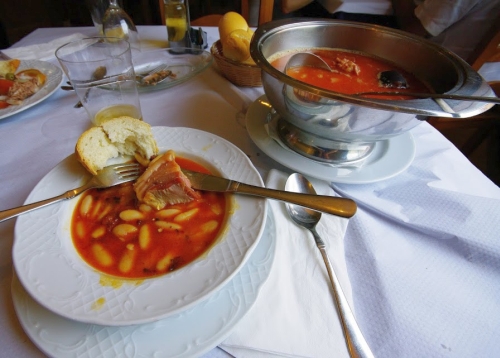
Perhaps more than anything else, the region stands for fabada asturiana, a legendary regional stew, available in any supermarket in the country, canned in a form that bears almost no resemblance to the home-cooked original. The main ingredients are large white beans, cured shoulder of pork (lacón), blood sausage (morcilla) and chorizo. If you can get through a massive Asturian portion, and if you can keep the foolish grin off your face while you’re at it, you’re a better man than me.
Asturias is a place to be outdoors. The summer here is warm but temperate enough to make walking or cycling comfortable. We hiked the Ruta de las Xanas (The Fairies’ Way), a well-known trail that begins just outside the town of Villanueva and ascends a deep gorge via precipitous pathways and rock tunnels. Navigating our way around a family of goats, we found ourselves in a little forest at the top, and beyond that an open, high valley where Casa Generosa, in the tiny hamlet of Pedroveya, serves a particularly recommended version of fabada. However, don’t try to go on Wednesday — it’s closed.
Down below in a long, deep valley, bicycles can be hired in the little town of Tuñon for the trip along the Senda del Oso (Path of the Bear), a route through the valley for around 12 astonishing miles along canyons and through more tunnels hewn through rock. This is bear country, and although notoriously elusive, if you want to see some you probably can. Paca and Tola, two orphan bears who live in semi-liberty just outside the town of Proaza, are fed daily at noon and you stand a good chance of spotting them when they come down from the mountain for their lunch.
We also walked the Valle del Lago, a 7 1/2-mile hike along gentle terrain that culminates at a beautiful glacial lake in the Somiedo Natural Park. Few stops on the trip brought it home so effectively that this is not the Spain of the brochures, of the package tours, Costa holidays and castanets. Think Switzerland. I’d seen images of the New Zealand wilderness that looked more like this than other parts of Spain do.
It wasn’t all walking. A moment that has stayed with us was the morning when we got no further than the wooden bench outside our chalet, high on a mountaintop overlooking the most beautifully located swimming pool I’ve ever seen in my life and the valley below. Across from us the first shaft of golden light from the rising sun illuminated the long, rocky ridge of El Angliru on the other side of the valley. Lower down the land was cultivated and crisscrossed with hedgerows. Streams adorned the slopes and beside them little huts and cottages pocked the mountainsides like crumbs in the folds of a sheet.
We just sat there, a cup of instant coffee each, and we didn’t say a thing. We couldn’t have imagined a beach a big hotel or a noisy family at that moment. The only sound was bells; an unhurried melody chimed out from some church in the valley below and, closer to hand, the tinkling of cowbells as the locals grazed.
Not one word. All we could do was look. Breathe in the air, try to get our heads around what we were looking at. Nobody in sight. All the space in the world, all the quiet. Peace. Asturias. Spain.
By Robin Graham

ABOUT THE AUTHOR
 Robin Graham has written for In Madrid, The Expeditioner and the Matador Network. He regularly contributes to The Spain Scoop and blogs at the award-winning Alotofwind. Follow him on Twitter: @robinjgraham.
Robin Graham has written for In Madrid, The Expeditioner and the Matador Network. He regularly contributes to The Spain Scoop and blogs at the award-winning Alotofwind. Follow him on Twitter: @robinjgraham.
